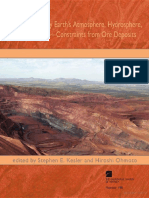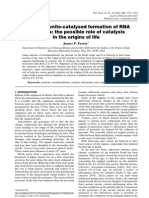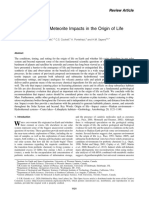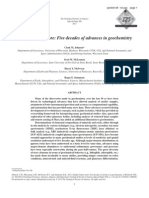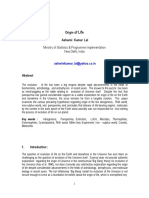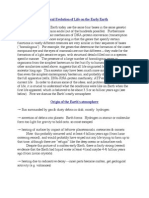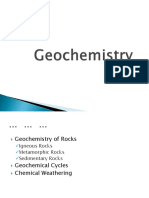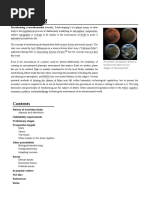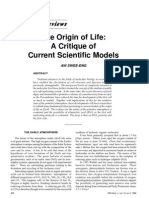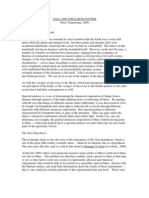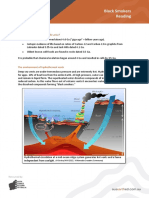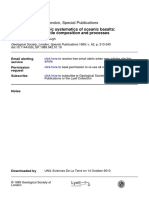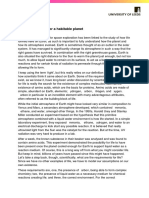Introduction: Conditions For The Emergence of Life On The Early Earth
Introduction: Conditions For The Emergence of Life On The Early Earth
Uploaded by
api-3713202Copyright:
Available Formats
Introduction: Conditions For The Emergence of Life On The Early Earth
Introduction: Conditions For The Emergence of Life On The Early Earth
Uploaded by
api-3713202Original Title
Copyright
Available Formats
Share this document
Did you find this document useful?
Is this content inappropriate?
Copyright:
Available Formats
Introduction: Conditions For The Emergence of Life On The Early Earth
Introduction: Conditions For The Emergence of Life On The Early Earth
Uploaded by
api-3713202Copyright:
Available Formats
Phil. Trans. R. Soc.
B (2006) 361, 1675–1679
doi:10.1098/rstb.2006.1895
Published online 7 September 2006
Introduction: conditions for the emergence
of life on the early Earth
Living entities exhibit the three fundamental charac- of meteorites, micro-meteorites and interplanetary
teristics of metabolism, growth and reproduction, to dust particles originating in comets and asteroids.
which we may add evolutionary adaptation to their The types and abundances of organic species that were
environment. Understanding how life having these formed on or off the Earth are discussed, in particular,
characteristics emerged on Earth within 1 Gyr of its in the context of possible processes leading to the
formation is both a fascinating scientific problem and a formation of amino acids, sugars, amphiphiles, etc.,
pre-requisite for predicting the presence of life else- which could be directly related to the origin or the early
where in the Universe. At the Discussion meeting on evolution of life. In a more speculative mood, Bernstein
the conditions for the emergence of life on the early considers briefly the problem of distinguishing between
Earth, held at the Royal Society, 13 and 14 February abiotic organic molecules from those that are actual
2006, scientists from several disciplines discussed the signs of life, as a part of a robotic search for life in the
origin of the biotic raw materials, and the conditions Solar System.
and dynamic processes involved in the genesis and the Grady & Wright (2006) discuss carbon cycles on the
early evolution of primitive life forms. This issue of early Earth, and more speculatively, on Mars, in terms
Philosophical Transactions B contains the papers of a complex interaction between the atmosphere, the
presented at the meeting, short accounts of which are hydrosphere and the lithosphere, and eventually with a
given in this Introduction. Questions to the speakers, reactive biosphere. The factors maintaining in balance
and their responses, are presented immediately the Earth’s carbon inventory are currently absent in
following each paper. In reflecting on the issues Mars, but may have existed in the past. The Earth’s
discussed, it is well to remember that extremely long carbon cycles have changed as its tectonic structure and
periods of time, of the order of millions and of billions its biological content have evolved. Knowledge of this
(giga) of years are involved, periods which are evolution, adapted to a Martian context, and consider-
conceptually difficult to envisage in terms of our ation of the sources and sinks of carbon on Mars based
everyday cognizance of dynamic action and change. on the carbon chemistry of Martian meteorites, make it
The first session was mainly devoted to the study of possible to investigate evidence for a Martian bio-
molecules in prebiotic settings, beginning with the sphere. At the present time there appears to be little
paper by Thaddeus (2006) on prebiotic molecules such evidence.
observed in the interstellar gas by astrophysical If life exists or existed on Mars, what are its possible
spectroscopy, principally in the radiofrequency region. signatures? This subject is presented by Anand et al.
After rapidly detailing the known interstellar and (2006). For life to survive, the presence of liquid water
circumstellar molecules, with emphasis on those is thought to be essential. Recent space missions have
containing the most abundant biogenic elements, reinforced earlier suggestions that Mars was once
Thaddeus mentions the positive qualitative and warmer and wetter, and have also suggested that the
quantitative analytical capacity of radioastronomy for Martian landscape was shaped by processes similar to
identifying interstellar species and determining their those operating on our own Earth. Evidence of past
physical environment. The problems discussed con- aqueous activity on Mars can be obtained through
cern the possible identification of interstellar aminoa- mineral, chemical and isotopic studies of primary
cids, as well as of polycyclic aromatic hydrocarbons and secondary minerals in Martian meteorites. This
(PAHs) which have been suggested to be the most paper includes studies of the action and effects of water
abundant organic molecules in the Universe and which on Mars by using as diagnostic the fractionation
may be stepping stones to building up interstellar of iron isotopes, which can be significant during
grains. However, the negative result of an astronomical low-temperature alteration processes. The biological
spectral search for the known microwave spectrum of influence on fractionation is currently under investi-
corannulene puts the PAH hypothesis in jeopardy until gation. The results might be used to distinguish, for
specific PAHs are identified by astronomical example, low-temperature abiotic processes from
spectroscopy. biological activity on Mars.
Bernstein (2006) reviews the possible terrestrial The physical and chemical conditions on the early
formation mechanisms of pre-biotic organic molecules, Earth were subjects of the second session, which opens
such as by Miller–Urey synthesis, and in hydrothermal with a contribution by Lunine (2006) who begins by
vents, which he somewhat favours. He also considers tracing the various events and factors that led to the
the input of prebiotic material from space in the form formation of the Earth, including collisions with large
bodies. There occurred a complex early history of
One contribution of 19 to a Discussion Meeting Issue ‘Conditions for infrequent, catastrophic, giant collisions against a
the emergence of life on the early Earth’. background rain of impacts from more numerous and
1675 q 2006 The Royal Society
1676 S. Leach and others Introduction
smaller debris in the Hadean period (4.56–4.0 Gyr complementary transcript in order for the parent self-
ago) during which the Moon was born in the very early replicating RNA to discriminate its own sequence from
stages via a collisional process. Computer simulation of all others. Taylor’s solution involves synthesis of a
the processes leading to the formation of the Earth and parallel complementary copy of the RNA polymerase.
the Moon has advanced our knowledge in this area. The results of model simulations suggest that an
Lunine discusses various sources of water on the Earth operational temperature up to 908C would allow a
and considers how, as accretion tailed off and the replicase using a parallel complement to be viable. This
Earth’s crust cooled, surface liquid water became stable molecular model leads to proposals for the structural
within 500 Myr of Earth’s origin, perhaps sooner. The nature of the replicase. The function of a replicase
presence of water and high heat flows, coupled with other requires it to bind both a template and a transcript
conditions different from those of today, has significant along with a nucleotide monomer, difficult to achieve
implications for the atmosphere and for the chemistry of with known ribozyme structures. Taylor proposes that
organics, including those at the oceanic geothermal sites. this requires a ribosome as a suitable structure
The possibilities and interest of exploration of Venus, Io, containing the required active sites. The final model
Europa and Titan as planetary analogues of the early incorporates the synthesis of a polypeptide chain
Earth environment are presented. regulated by tRNA-like molecules that impose a ratchet
The atmospheric composition and climate on the mechanism in steps of three bases along a template.
early Earth are important factors determining the The contribution of Szathmáry (2006) also deals
emergence of life and the nature of primitive organisms. with the origin of informational replicators (of which
Kasting & Howard (2006) discuss the early atmosphere genes are but an example) and reproducers, which are
and climate, the data being based mainly on analyses of necessary for biological evolution to occur. The
oxygen and sulphur isotopes in various materials from appropriate selection dynamics and chemical con-
the Archaean and Proterozoic epochs, and also on ditions are considered. The importance of the error
evidence for global glaciation periods in the Proterozoic. threshold in copying fidelity is emphasized. A non-
They argue in favour of a temperate early Earth, possibly informational replicator, such as an intermediate in the
during the period when life arose, rather than the formose reaction, is used as a model to discuss the decay
previous estimates of 45–858C for surface temperatures. threshold. After a discussion of infrabiological systems,
An important factor in the argument for a temperate which are systems lacking one of the key subsystems of
early Earth concerns changes in seawater isotopic
life, such as a metabolic subsystem, and defining
composition, a new mechanism for which is outlined.
composomes (a group of molecules each exerting
Warm, temperate and ‘snowball Earth’ conditions are
some catalytic function within a lipid context),
considered as having existed at various epochs, reasons
Szathmáry uses these concepts to create dynamic
for the changes of climate between hot and cold being
models of (pre)biotic growth and evolution. He then
the matter of study and speculation. These changes have
develops a model based on chemical reactions occurring
implications for the development of life as well as
on a chromatographic column considered as a series of
possibly reflecting the effects of life on the climate.
connected cells. This chromatographized replicator
With the contribution of Schwartz (2006), we enter
detailed discussion of the synthesis of compounds that model, which could be subject to experimental test, is
have fundamental biochemical functions. He stresses considered by Szathmáry to be relevant to the origin of
the importance of prebiotic synthesis of phosphorus- life on Earth. The coexistence of unlinked replicators
containing species such as nucleotides and polynucleo- constituting a primordial genome is shown to be
tides for the emergence of life. This synthesis requires possible by involving various factors, including chaotic
not only a geological source of reactive phosphorus flows, surface dynamics and compartmentalization.
compounds, but also reasonable pathways for their The next few papers, although harnessed on
incorporation into chemical systems on the primitive theoretical concepts concerning the formation of
Earth. Schwartz shows that for the mineral apatite, basic biochemical components in the emergence of
which is the principal source of phosphate on Earth, life, are firmly based on experimental studies of the
there are at least two pathways that overcome problems relevant physicochemical processes. After a brief
of low solubility and reactivity. The mineral schreiber- discussion of possible sources of the reduced
site in meteorites is a possible extraterrestrial source of compounds on the primitive Earth, Ferris (2006)
reactive phosphorus. describes the clay-catalysed formation of RNA oligo-
Possible steps leading from abiotic chemistry to a mers. Montmorillonite which, on Earth, can be formed
living entity were the subject of the third session, which by the weathering of volcanic ash, and which has
dealt with the development of biology. It began with a recently been detected on Mars, is capable of catalysing
paper by Taylor (2006) on conceptual and molecular the formation of oligomers of RNA that contain up to
model studies bearing on the origin of transcription and 50 monomer units. It is also capable of catalysing
translation of information in an RNA world, a vesicle formation. The processes studied exhibit
biological world prior to protein synthesis whose sequence selectivity, which restricts the number of
conceptual possibility was much enhanced by the oligomer isomers formed, regioselectivity in phospho-
discovery that RNA molecules can possess catalytic diester bond formation and homochiral selectivity in
activity. His approach avoids difficulties or certain dimer formation. The preferred possible role of
inefficiencies in the RNA-copying process and in selective catalysis, as compared with specific catalysis
particular the necessity of mechanisms for keeping on a specific substrate, is discussed in terms of its
separate the template RNA strand and its reverse bearing on the origin of life.
Phil. Trans. R. Soc. B (2006)
Introduction S. Leach and others 1677
Wächtershäuser (2006) develops his theory of life would be an aqueous phase at temperatures
a chemi-autotrophic origin of life in a volcanic not above 608C and of low ionic strength. These
iron–sulphur world. This postulates a pioneer organism characteristics are very different from those of other
of life, which emerged at sites of reducing magmatic proposed sites for the origin of life, such as geothermal
exhalations approximately 4.4 billion years ago. The or marine environments.
first living organism, the so-called pioneer organism, a In the final session, devoted to early ecosystems and
starting point in evolution, is characterized by an manifestations of early life, the paper by Canfield et al.
inorganic substructure that is catalytically active. It (2006) discusses anoxic ecosystems in the early Earth.
promotes the growth of an organic superstructure These include ecosystems involving the cycling of
lying within a volcanic liquid water phase that is the hydrogen and methane as well as a variety of iron,
source of chemical nutrients. The pioneer organism sulphur and nitrogen compounds. From the structure of
is shown to have potential for growth, for reproduction these systems and the source strength of electron donors
by ligand feedback and for evolution by double and acceptors, whose availability for fuelling early
catalytic feedback. The experimental studies of anaerobic metabolisms is explored, it is possible to
various chemical stages are described. The develop- estimate that the primary production rates of the
ment of cellularization via lipid synthesis and bilayer ecosystems in the ancient biosphere would have been
membrane formation is discussed, along with poly- much smaller than in today’s biosphere. Oxygenic
condensation, enzymatization and nucleic acid replica- photosynthesis, which originated with the evolution of
tion. The chemi-autotrophic model, involving a direct cyanobacteria, is the dominant factor in biological
mechanism of evolution by variation of peptide activity today. Its arrival some 2 Gyr ago dramatically
synthesis and peptide feedback, developed later into modified the diversity and the magnitude of life on the
an indirect, stochastic, genetic mechanism involving Earth. The geological record, examined as to its clues
variations of mRNA sequences due to replication concerning the activity level of the ancient biosphere,
variations. A discussion on the pre-cell concept of including the carbon cycle, favours an Fe-based anoxy-
Kandler leads to the conclusion that all forms of life genic photosynthetic ecosystem in the early Archaean.
from the pioneer organism to the pre-cells must have A carbon cycle driven by oxygen photosynthesis, where
been hyperthermophiles. The possible evolution of pre- the oxygen produced is removed by reaction with reduced
cells into the bacteria, archaea and eukarya domains is species in the Earth’s mantle, thus maintaining an anoxic
described. The evolution of life, usually thought of in atmosphere, is also thought to be possible.
terms of adaptation to its environment, is characterized Stetter (2006) reviews the role of hyperthermophiles
by an increase in molecular complexity, which has its in the history of life. Hyperthermophilic bacteria and
origins in the nature of redox chemistry active in the archaea have been observed within terrestrial, sub-
metabolic processes prevalent in the pioneer organism. terranean and submarine high-temperature environ-
Modelling self-assembly processes in the prebiotic ments occurring mainly along tectonic spreading and
environment is the theme of the contribution of subduction zones. They exist essentially in anaerobic
Deamer et al. (2006). They discuss related themes environments, where they gain energy by inorganic
that can be used to guide research on the origin of life. redox reactions involved in a chemolithoautotrophic
The first concerns its site on the early Earth, where mode of nutrition. Stetter discusses examples of
liquid water, appropriate organic compounds, and an recently discovered hyperthermophilic archaea, in
adequate source of the energy required to carry out particular, a group of small ‘nano-archaea’ which
synthetic reactions must be available. The second might have existed on the early Earth. The position of
theme concerns chemical and physical properties of hyperthermophiles within the phylogenetic tree of life
the organic compounds available to participate in the provides evidence for the last common ancestor (LCA)
origin of life, in particular, their capacity for poly- to have been a hyperthermophile. Furthermore, they
merization and their amphiphilic quality, a property are known to survive deep-freezing at K1408C, so that
that permits self-assembly into membrane-bounded within impact ejecta, they could have at least survived
compartments that can encapsulate molecular com- the temperatures associated with transfer to other
ponents, thus forming microscopic reactors. Deamer planets and moons through cold space.
et al. report recent studies in which self-assembly The consequences of the considerable impact
processes of organic compounds were investigated in bombardment of the early Earth on the origin and the
two natural geothermal environments (Kamchatka and emergence of life are discussed in the contribution of
Mount Lassen), where the hot spring sites include Cockell (2006). The craters formed by asteroid and
boiling clay-lined ponds. These ponds are possible comet impacts are possible favourable sites for prebiotic
manifest variants of Darwin’s offhand suggestion of a chemistry during the Hadean epoch, possibly mimic-
‘warm little pond’ for the site of the first production of a king a version of Darwin’s ‘warm little pond’. In these
living organism. The experiments followed the physi- sites can occur the formation of various metal sulphides,
cochemical fates of a set of suitable organic solutes and clays and zeolites which can act as templates for
phosphate, forming a possible prebiotic mixture, which prebiotic reactions. Non-acidic hydrothermal con-
were added to these acidic ponds. The results showed ditions can favour molecular binding to mineral
that the organic compounds were adsorbed onto clay surfaces, while intense fracturing of rock during impact
surfaces, impeding chemical reactions between them, can create extensive surfaces for chemical reactions to
and that self-assembly of boundary structures cannot occur. Meteorite impact deliveries can provide further
occur under hot acidic conditions. It was concluded substrates for prebiotic reactions, and the existence of
that the most plausible environment for the origin of diverse impact energies from incoming objects could
Phil. Trans. R. Soc. B (2006)
1678 S. Leach and others Introduction
result in different rates of hydrothermal cooling. eventually allowing for selection, evolutionary adap-
Furthermore, the variety of impacts could lead to tation and self-reproduction, is explored in terms of the
many different sets of local environment conditions relevant physical chemistry. The subject of impact
and so provide the circumstances for what is virtually a events is discussed in some detail and new pertinent
large number of different ‘experiments’ concerning the information on laboratory experiments involving the
origin of life. The physicochemical conditions in a range impact of high-energy clusters on solid surfaces is
of crater sites are explored in the context of prebiotic described and its possible relevance to astronomical
reactions that lead eventually to early life. Cockell impact events is evoked. The simulations involving the
presents a possible overall scheme for the origin of life extreme physical conditions in such laboratory experi-
within impact craters, all the way from prebiotic ments could be of interest for producing the building
reactions to the emergence of self-replicating systems, blocks of biomolecules.
remarking that similar prebiotic processes could be Jortner sketches two different approaches to
sought in Martian impact craters. The craters are shown considerations on the origin of life. The bottom-up
to provide habitats protected from environmental approach involves the nanofabrication of biomolecules
extremes, which can support the growth of diverse by catalysis of their chemical building blocks, whose
organisms, relevant in particular to the existence and nature depends in part on the atmospheric conditions
growth of microbial communities on the early Earth. and energy sources on the early Earth, followed by self-
Before the presence of oxygen, generatix of protective organization leading eventually to complex biological
ozone, in the atmosphere, the Earth was bathed in UV matter. The problem of encapsulation of biochemical
light, which should have been destructive of life forms. components of biotic significance, eventually in cell
Westall et al. (2006) investigate the UV conditions on the structures, is discussed. An analysis is made of the need
early Earth as indicated by the existence and formation of and the methods for restriction of compositional and
3.4 Gyr old filamentous microbial mats, and rod and conformational redundancy in the synthesis of proteins
vibroid structures embedded in a smooth film, found as and nucleic acids. The top-down approach also
fossilized structures in shallow water sediments in South emphasizes the role of self-organization, but approaches
Africa and considered to be formed by anoxygenic this question in the reverse order, i.e. by deconstructing
photosynthetic micro-organisms. The biogenic nature functional living matter to small units that still exhibit
of the fossils is demonstrated by methods that clarify the biological functions, and also by determining phyloge-
necessary geological, physical and chemical tests for netic relationships down to the LCA and beyond to the
differentiating them from abiogenic artefacts or more minimum set of genes necessary for cellular function-
recent contaminants. The structure of the microbial mats ality. In a concluding section, Jortner evokes several
is analysed to provide information on the fossilization open questions in the origin of life story, among which
process and the state of the organic matter within it. The are: (i) the origin of biomolecular chirality, (ii) the need
morphological, chemical and other characteristics of the for much more experimental testing of theoretical
mat components are the same as those of modern micro- models of self-organization processes, (iii) understand-
organisms, including colony and biofilm formation. ing the prebiotic origin of RNA, (iv) clarifying the
Interaction of the biofilms with the local environment properties of the LCA, (v) determining the level of
of sediment particles and flowing water, as well as molecular–supramolecular–nanostructural complexity
desiccation and rapid silification processes are shown to required for biological function to become manifest and
have occurred. The filamentous microbial mat and the (vi) clarifying the time-scales for the emergence of life in
rod/vibroid colony appear to have been in a healthy state the context of cosmological and geological dynamic
when fossilized, although they were directly exposed to factors.
the atmosphere. A thin organic smog formed by
photolysis of methane could have helped to provide UV Sydney Leach1
protection of the early micro-organisms. Ian W. M. Smith2
The conclusion to a very lively meeting is given in a Charles S. Cockell3 April 2006
paper by Jortner (2006), who summarizes the nature of
1
the presentations, and embeds some of them in LERMA, Observatoire de Paris-Meudon,
discussions on the origin of prebiotic chemicals and 92195 Meudon, France
on the conditions and constraints for life to appear. He (sydney.leach@obspm.fr)
2
also presents his reflections on models and processes Department of Chemistry, University of Cambridge,
concerning the emergence of life. He emphasizes Lensfield Road, Cambridge CB2 1EW, UK
3
structure–function relationships in biology, comple- Center for Earth, Planetary and Astronomical Research,
mented by dynamic energy transfer aspects. The Open University, Milton Keynes MK7 6AA, UK
development of increasing complexity of matter from
the elementary chemical bricks up to functional living
entities is sketched. The essential knowledge gap in this
REFERENCES
holistic framework is the passage from self-organized
Anand, M., Russell, S. S., Blackhurst, R. L. & Grady, M. M.
complex matter to living matter. Bridging this gap 2006 Searching for signatures of life on Mars: an Fe
requires that we reach an adequate definition of life, a isotope perspective. Phil. Trans. R. Soc. B 361, 1715–1720.
task explored but shown to be difficult to achieve with (doi:10.1098/rstb.2006.1899)
entire satisfaction. The concept of molecular infor- Bernstein, M. 2006 Prebiotic materials from on and off
mation is discussed and its role in information-driven the early Earth. Phil. Trans. R. Soc. B 361, 1689–1702.
self-organization (self-assembly) processes of matter, (doi:10.1098/rstb.2006.1913)
Phil. Trans. R. Soc. B (2006)
Introduction S. Leach and others 1679
Canfield, D. E., Rosing, M. T. & Bjerrum, C. 2006 Early Schwartz, A. W. 2006 Phosphorus in prebiotic chemistry.
anaerobic metabolisms. Phil. Trans. R. Soc. B 361, Phil. Trans. R. Soc. B 361, 1743–1749. (doi:10.1098/rstb.
1819–1836. (doi:10.1098/rstb.2006.1906) 2006.1901)
Cockell, C. S. 2006 The origin and emergence of life under Stetter, K. O. 2006 Hyperthermopiles in the history of life.
impact bombardment. Phil. Trans. R. Soc. B 361, Phil. Trans. R. Soc. B 361, 1837–1843. (doi:10.1098/rstb.
1845–1856. (doi:10.1098/rstb.2006.1908) 2006.1907)
Deamer, D., Singaram, S., Rajamani, S., Kompanichenko, V. Szathmáry, E. 2006 The origin of replicators and reprodu-
& Guggenheim, S. 2006 Self-assembly processes in cers. Phil. Trans. R. Soc. B 361, 1761–1776. (doi:10.1098/
the prebiotic environment. Phil. Trans. R. Soc. B 361, rstb.2006.1912)
1809–1818. (doi:10.1098/rstb.2006.1905) Taylor, W. R. 2006 Transcription and translation in an RNA
Ferris, J. P. 2006 Montmorillonite-catalyzed formation of world. Phil. Trans. R. Soc. B 361, 1751–1760. (doi:10.
RNA oligomers: the possible role of catalysis in the origins 1098/rstb.2006.1910)
of life. Phil. Trans. R. Soc. B 361, 1777–1786. (doi:10. Thaddeus, P. 2006 The prebiotic molecules observed in the
1098/rstb.2006.1903) interstellar gas. Phil. Trans. R. Soc. B 361, 1681–1687.
Grady, M. M. & Wright, I. 2006 The carbon cycle on early (doi:10.1098/rstb.2006.1897)
Earth—and on Mars? Phil. Trans. R. Soc. B 361, Wächtershäuser, G. 2006 From volcanic origins of chemo-
1703–1713. (doi:10.1098/rstb.2006.1898) autotrophic life to Bacteria, Archaea and Eukarya. Phil.
Jortner, J. 2006 Conditions for the emergence of life on the Trans. R. Soc. B 361, 1787–1808. (doi:10.1098/rstb.2006.
early Earth: summary and reflections. Phil. Trans. R. Soc. 1904)
B 361, 1877–1891. (doi:10.1098/rstb.2006.1909) Westall, F., deRonde, C. E. J., Southam, G., Grassineau, N.,
Kasting, J. F. & Howard, M. 2006 Atmospheric composition Colas, M., Cockell, C. & Lammer, H. 2006 Implications
and climate on the early Earth. Phil. Trans. R. Soc. B 361, of a 3.472–3.333 Gyr-old subaerial microbial mat
1733–1742. (doi:10.1098/rstb.2006.1902) from the Barberton greenstone belt, South Africa for
Lunine, J. I. 2006 Physical conditions on the early Earth. Phil. the UV environmental conditions on the early Earth.
Trans. R. Soc. B 361, 1721–1731. (doi:10.1098/rstb.2006. Phil. Trans. R. Soc. B 361, 1857–1875. (doi:10.1098/rstb.
1900) 2006.1896)
Phil. Trans. R. Soc. B (2006)
You might also like
- Evolution of Early Earth's Atmosphere, Hydrosphere, and Biosphere, Constraints From Ore DepositsDocument333 pagesEvolution of Early Earth's Atmosphere, Hydrosphere, and Biosphere, Constraints From Ore DepositsVictor Alejandro Faundez OlivosNo ratings yet
- Philosophical Transaction Royal Soc.Document216 pagesPhilosophical Transaction Royal Soc.Maritza Fajardo EscobarNo ratings yet
- Searching For Signatures of Life On Mars: An Fe-Isotope PerspectiveDocument6 pagesSearching For Signatures of Life On Mars: An Fe-Isotope Perspectiveapi-3713202No ratings yet
- Montmorillonite-Catalysed Formation of RNA Oligomers: The Possible Role of Catalysis in The Origins of LifeDocument10 pagesMontmorillonite-Catalysed Formation of RNA Oligomers: The Possible Role of Catalysis in The Origins of Lifeapi-3713202No ratings yet
- Ast 2019 2203Document29 pagesAst 2019 2203Evoleth SalcedoNo ratings yet
- The Origin and Emergence of Life Under Impact Bombardment: Charles S. CockellDocument12 pagesThe Origin and Emergence of Life Under Impact Bombardment: Charles S. Cockellapi-3713202No ratings yet
- The Carbon Cycle On Early Earth-And On Mars?: Monica M. Grady and Ian WrightDocument11 pagesThe Carbon Cycle On Early Earth-And On Mars?: Monica M. Grady and Ian Wrightapi-3713202No ratings yet
- Sahai - 2016 - Transition Geochemistry To BiogeochemistryDocument6 pagesSahai - 2016 - Transition Geochemistry To BiogeochemistryAnonymous YSnVjegNo ratings yet
- Johnson Et Al 2013 GSA Spec PapDocument44 pagesJohnson Et Al 2013 GSA Spec PapclarklipmanNo ratings yet
- (Kitadai & Maruyama, 2018) Origins of Building Blocks of Life. A ReviewDocument37 pages(Kitadai & Maruyama, 2018) Origins of Building Blocks of Life. A ReviewOscar Leonardo Aaron Arizpe VicencioNo ratings yet
- Esd 2010 2 Discussions Typeset Source Version5Document14 pagesEsd 2010 2 Discussions Typeset Source Version5Karo MichaelianNo ratings yet
- JPL Pub. 01-7 (Part 1)Document8 pagesJPL Pub. 01-7 (Part 1)Bope GoodNo ratings yet
- A System's View of The Evolution of LifeDocument22 pagesA System's View of The Evolution of LifeKartik SrinivasanNo ratings yet
- Origin of Life On EarthDocument32 pagesOrigin of Life On EarthMKey ChUhnNo ratings yet
- TMP 21 A7Document8 pagesTMP 21 A7FrontiersNo ratings yet
- Prebiotic Materials From On and Off The Early Earth: Max BernsteinDocument14 pagesPrebiotic Materials From On and Off The Early Earth: Max Bernsteinapi-3713202No ratings yet
- The Tree of Life: An Introduction To Biological Diversity: Chapter 26Document15 pagesThe Tree of Life: An Introduction To Biological Diversity: Chapter 26denisNo ratings yet
- Clays and The Origin of Life: The ExperimentsDocument55 pagesClays and The Origin of Life: The ExperimentsMark MaryassovNo ratings yet
- Chemical Evolution of Life On The Early EarthDocument16 pagesChemical Evolution of Life On The Early EarthManureghukumar94No ratings yet
- History of Scholarly Study: Collision Orbit Astounding Science FictionDocument6 pagesHistory of Scholarly Study: Collision Orbit Astounding Science FictionSatheesh KumarNo ratings yet
- Future Mars Sample ReturnDocument2 pagesFuture Mars Sample ReturnReimon Carl John PanunciaNo ratings yet
- Introduction To GeochemistryDocument24 pagesIntroduction To GeochemistryIjlal Ahmad100% (1)
- Terraforming: An Artist's Conception Shows A Terraformed Mars in Four Stages of DevelopmentDocument10 pagesTerraforming: An Artist's Conception Shows A Terraformed Mars in Four Stages of DevelopmentDoktormin106No ratings yet
- Tjv10n3 Origin LifeDocument15 pagesTjv10n3 Origin Lifekhes87No ratings yet
- Gaia and The Earth SystemDocument8 pagesGaia and The Earth Systemken455No ratings yet
- Geochemical Influences On Life's Origins and Evolution: Joseph V. SmithDocument6 pagesGeochemical Influences On Life's Origins and Evolution: Joseph V. SmithErnesto MarchantNo ratings yet
- 4-Billion-Year-Old Nitrogen-Containing Organic Molecules Discovered in Martian Meteorites - ScienceDailyDocument5 pages4-Billion-Year-Old Nitrogen-Containing Organic Molecules Discovered in Martian Meteorites - ScienceDailyaryankhan57647No ratings yet
- A1.1 The Origins of Life - 2018Document50 pagesA1.1 The Origins of Life - 2018Wayne DayataNo ratings yet
- Mineral Evolution - HazenDocument28 pagesMineral Evolution - HazenAsri Gani100% (1)
- PMC1578733Document18 pagesPMC1578733Leonardo CorreiaNo ratings yet
- Summer Assignment Scan PDFDocument58 pagesSummer Assignment Scan PDFDavid CaseyNo ratings yet
- How Life Began On EarthDocument15 pagesHow Life Began On EarthDilan9318No ratings yet
- LDocument18 pagesLRituparna KalitaNo ratings yet
- 3 s2.0 B9780323957175000657 MainDocument4 pages3 s2.0 B9780323957175000657 MainPhương Trần100% (1)
- Scientific Point of View of The Origin of The Universe, Earth, and LifeDocument3 pagesScientific Point of View of The Origin of The Universe, Earth, and LifeRENE N. RAMILONo ratings yet
- BIOS1107 Notes - 1.08Document7 pagesBIOS1107 Notes - 1.08Jaylene Jin-Young KimNo ratings yet
- Chidrawi M3 Ch01Document10 pagesChidrawi M3 Ch01Victor PhamNo ratings yet
- The Origin and Early Evolution of Life: Prebiotic Chemistry, The Pre-RNA World, and TimeDocument10 pagesThe Origin and Early Evolution of Life: Prebiotic Chemistry, The Pre-RNA World, and TimePaula FerruchoNo ratings yet
- Black Smokers ReadingDocument3 pagesBlack Smokers ReadingSasaNo ratings yet
- Atreya 2007 Metano en MarteDocument12 pagesAtreya 2007 Metano en MarteMario Kadéll Silva FerreyraNo ratings yet
- Studyguide PDFDocument6 pagesStudyguide PDFDigital GlitchNo ratings yet
- Epe Rho8 InsDocument7 pagesEpe Rho8 InsyarencayirNo ratings yet
- The Evolution of The Atmosphere in The Archaean and Early ProterozoicDocument10 pagesThe Evolution of The Atmosphere in The Archaean and Early Proterozoichouda talbiNo ratings yet
- AstrochemestryDocument2 pagesAstrochemestry1 1No ratings yet
- AstrobiologyDocument4 pagesAstrobiologyygnakumarNo ratings yet
- paper on Earth evolutionDocument3 pagespaper on Earth evolutionchat.palviNo ratings yet
- Mineral EvolutionDocument29 pagesMineral EvolutionDouglas SantosNo ratings yet
- Sun-Mcdonough 1989Document34 pagesSun-Mcdonough 1989Pedro LópezNo ratings yet
- Life From Space: Astrobiology and PanspermiaDocument5 pagesLife From Space: Astrobiology and PanspermiaPabloAPachecoNo ratings yet
- The Search For Life or A Habitable PlanetDocument2 pagesThe Search For Life or A Habitable PlanetSajjad HushamNo ratings yet
- Exploring The Potential Excrements of Hypothetical Martian Life - Biological and Ecological ImplicationsDocument3 pagesExploring The Potential Excrements of Hypothetical Martian Life - Biological and Ecological ImplicationsgenglerenNo ratings yet
- E&L Science SummaryDocument4 pagesE&L Science Summarymissyyours07107No ratings yet
- Evolution Earth AtmosphereDocument8 pagesEvolution Earth AtmosphereMonica UrbietaNo ratings yet
- Mars Facts Devil and AngelsDocument3 pagesMars Facts Devil and Angelslincoln hernandezNo ratings yet
- Eo066i028p00538 PDFDocument2 pagesEo066i028p00538 PDFBaalaji RavichandranNo ratings yet
- Genbiol - Origin of Life Reaction PaperDocument2 pagesGenbiol - Origin of Life Reaction PaperAra Marie Magnaye75% (8)
- A Compendium of Geochemistry: From Solar Nebula to the Human BrainFrom EverandA Compendium of Geochemistry: From Solar Nebula to the Human BrainNo ratings yet
- Elemental: How Five Elements Changed Earth’s Past and Will Shape Our FutureFrom EverandElemental: How Five Elements Changed Earth’s Past and Will Shape Our FutureNo ratings yet
- The Fragile Balance: Understanding Earth and Environmental ScienceFrom EverandThe Fragile Balance: Understanding Earth and Environmental ScienceNo ratings yet
- Self-Assembly Processes in The Prebiotic EnvironmentDocument10 pagesSelf-Assembly Processes in The Prebiotic Environmentapi-3713202No ratings yet
- Conditions For The Emergence of Life On The Early Earth: Summary and ReflectionsDocument15 pagesConditions For The Emergence of Life On The Early Earth: Summary and Reflectionsapi-3713202No ratings yet
- 17Document19 pages17api-3713202No ratings yet
- From Volcanic Origins of Chemoautotrophic Life To Bacteria, Archaea and EukaryaDocument22 pagesFrom Volcanic Origins of Chemoautotrophic Life To Bacteria, Archaea and Eukaryaapi-3713202No ratings yet
- The Origin of Replicators and Reproducers: Eo Rs Szathma RyDocument16 pagesThe Origin of Replicators and Reproducers: Eo Rs Szathma Ryapi-3713202No ratings yet
- Sedimentary Evidence of Early - Late Permian Mid-Latitude Continental Climate Variability, Southern Bogda Mountains, NW ChinaDocument14 pagesSedimentary Evidence of Early - Late Permian Mid-Latitude Continental Climate Variability, Southern Bogda Mountains, NW Chinaapi-3713202No ratings yet
- 07Document10 pages07api-3713202No ratings yet
- Phosphorus in Prebiotic Chemistry: Alan W. SchwartzDocument7 pagesPhosphorus in Prebiotic Chemistry: Alan W. Schwartzapi-3713202No ratings yet
- Transcription and Translation in An RNA World: William R. TaylorDocument10 pagesTranscription and Translation in An RNA World: William R. Taylorapi-3713202No ratings yet
- The Carbon Cycle On Early Earth-And On Mars?: Monica M. Grady and Ian WrightDocument11 pagesThe Carbon Cycle On Early Earth-And On Mars?: Monica M. Grady and Ian Wrightapi-3713202No ratings yet
- Physical Conditions On The Early Earth: Jonathan I. LunineDocument11 pagesPhysical Conditions On The Early Earth: Jonathan I. Lunineapi-3713202No ratings yet
- Record of The End-Permian Extinction and Triassic Biotic Recovery in The Chongzuo-Pingguo Platform, Southern Nanpanjiang Basin, Guangxi, South ChinaDocument18 pagesRecord of The End-Permian Extinction and Triassic Biotic Recovery in The Chongzuo-Pingguo Platform, Southern Nanpanjiang Basin, Guangxi, South Chinaapi-3713202No ratings yet
- 19Document21 pages19api-3713202No ratings yet
- Prebiotic Materials From On and Off The Early Earth: Max BernsteinDocument14 pagesPrebiotic Materials From On and Off The Early Earth: Max Bernsteinapi-3713202No ratings yet
- The Permian - Triassic Boundary at Nhi Tao, Vietnam: Evidence For Recurrent Influx of Sulfidic Watermasses To A Shallow-Marine Carbonate PlatformDocument24 pagesThe Permian - Triassic Boundary at Nhi Tao, Vietnam: Evidence For Recurrent Influx of Sulfidic Watermasses To A Shallow-Marine Carbonate Platformapi-3713202No ratings yet
- 24Document13 pages24api-3713202No ratings yet
- The Lower Triassic Cyclic Deposition in Chaohu, Anhui Province, ChinaDocument12 pagesThe Lower Triassic Cyclic Deposition in Chaohu, Anhui Province, Chinaapi-3713202No ratings yet
- Conodont Biostratigraphic Control On Transitional Marine To Non-Marine Permian - Triassic Boundary Sequences in Yunnan - Guizhou, ChinaDocument10 pagesConodont Biostratigraphic Control On Transitional Marine To Non-Marine Permian - Triassic Boundary Sequences in Yunnan - Guizhou, Chinaapi-3713202No ratings yet
- Elevated Atmospheric CO and The Delayed Biotic Recovery From The End-Permian Mass ExtinctionDocument12 pagesElevated Atmospheric CO and The Delayed Biotic Recovery From The End-Permian Mass Extinctionapi-3713202No ratings yet
- The Lilliput Effect in The Aftermath of The End-Permian Extinction EventDocument13 pagesThe Lilliput Effect in The Aftermath of The End-Permian Extinction Eventapi-3713202No ratings yet
- 11Document25 pages11api-3713202No ratings yet
- The Permian-Triassic Boundary Crisis and Early Triassic Biotic RecoveryDocument3 pagesThe Permian-Triassic Boundary Crisis and Early Triassic Biotic Recoveryapi-3713202No ratings yet
- How and Why Did The Lingulidae (Brachiopoda) Not Only Survive The End-Permian Mass Extinction But Also Thrive in Its Aftermath?Document14 pagesHow and Why Did The Lingulidae (Brachiopoda) Not Only Survive The End-Permian Mass Extinction But Also Thrive in Its Aftermath?api-3713202No ratings yet
- Conodont Biostratigraphy Across The Permian - Triassic Boundary at Chaotian, in Northern Sichuan, ChinaDocument17 pagesConodont Biostratigraphy Across The Permian - Triassic Boundary at Chaotian, in Northern Sichuan, Chinaapi-3713202No ratings yet
- Early Triassic Conodont - Palynological Biostratigraphy of The Meishan D Section in Changxing, Zhejiang Province, South ChinaDocument20 pagesEarly Triassic Conodont - Palynological Biostratigraphy of The Meishan D Section in Changxing, Zhejiang Province, South Chinaapi-3713202100% (1)
- Manhole Covers in Reinforced Composite For KMCDocument13 pagesManhole Covers in Reinforced Composite For KMCMukesh ParmarNo ratings yet
- Neutron LoggingDocument27 pagesNeutron Loggingsher afganNo ratings yet
- E Rickshaw Battery TestingDocument6 pagesE Rickshaw Battery Testingcare.wifinetNo ratings yet
- FAQ Selfheating Rev2Document2 pagesFAQ Selfheating Rev2GuljanNo ratings yet
- TDS - Premix Marine ThixotropeDocument3 pagesTDS - Premix Marine ThixotropegmNo ratings yet
- Test Information Guide: College-Level Examination Program 2012-13Document21 pagesTest Information Guide: College-Level Examination Program 2012-13j2thec07100% (1)
- Friction in PipesDocument13 pagesFriction in Pipes阿尔坎塔拉约翰·肯尼斯No ratings yet
- Ch102x51 - Moment Connection-Fm Panel PlatformDocument40 pagesCh102x51 - Moment Connection-Fm Panel PlatformPriya GopalNo ratings yet
- Nat ReviewDocument9 pagesNat ReviewForshia Antonette BañaciaNo ratings yet
- Design Check of Seismic Arrestor (Station)Document3 pagesDesign Check of Seismic Arrestor (Station)sesadimadennisNo ratings yet
- Sample PDF of STD 12th Perfect Chemistry Vol IDocument23 pagesSample PDF of STD 12th Perfect Chemistry Vol ISana Sana hamid shahNo ratings yet
- Earth and Life Grade 11Document4 pagesEarth and Life Grade 11Ezekiel LapitanNo ratings yet
- Penguard Tiecoat 100Document5 pagesPenguard Tiecoat 100Raja SNo ratings yet
- Thermal Modeling of A Concentrator Pipe Composed With Direct Steam GenerationDocument6 pagesThermal Modeling of A Concentrator Pipe Composed With Direct Steam GenerationHelen Denise Lugo MeNo ratings yet
- High Temperature Corrosion Exh ValvesDocument6 pagesHigh Temperature Corrosion Exh ValvesCvita CvitićNo ratings yet
- HeuristicsDocument13 pagesHeuristicsraja.mtNo ratings yet
- Ees Refprop PDFDocument8 pagesEes Refprop PDFomaaNo ratings yet
- 0620_s19_ms_41Document9 pages0620_s19_ms_41fakiha tajellieNo ratings yet
- Moving Conductor in A Static Magnetic FieldDocument7 pagesMoving Conductor in A Static Magnetic FieldNurul Aqiella PolanunuNo ratings yet
- Vat DyesDocument3 pagesVat DyesShrutiNo ratings yet
- 75 Gold Recovery MethodsDocument91 pages75 Gold Recovery MethodsJosé Julio Pantac Li100% (3)
- Earthquake Resistance StructureDocument20 pagesEarthquake Resistance StructureSahitya H MNo ratings yet
- Week6 11 Titration PHDocument99 pagesWeek6 11 Titration PH62100959No ratings yet
- Lecture. BiomaterialsDocument11 pagesLecture. BiomaterialsDam ThangNo ratings yet
- Band Structure and Transport Properties of Some 3-5 CompoundsDocument13 pagesBand Structure and Transport Properties of Some 3-5 CompoundsJose Leon GonzalezNo ratings yet
- Audit Checklist PICs 2021Document13 pagesAudit Checklist PICs 2021nsk79in0% (1)
- MODULE - 2 Elastic Properties of MaterialsDocument32 pagesMODULE - 2 Elastic Properties of Materialspatilanjali526No ratings yet
- Exit Exam ModelDocument12 pagesExit Exam ModelFira tubeNo ratings yet
- LPG FuelcellsDocument25 pagesLPG FuelcellsTrupti SahuNo ratings yet
